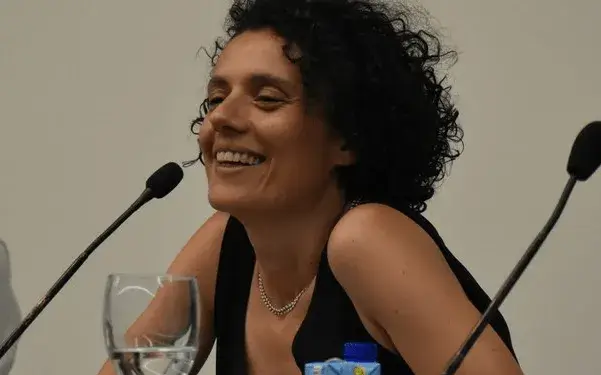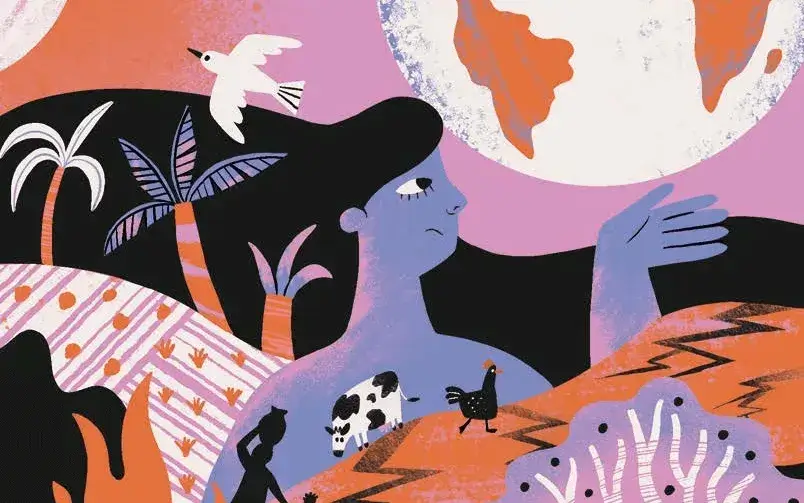Nerea Ramírez: "One of the most worrying trends we’ve observed is the loss of our ability as a society to imagine positive futures.”

In this interview with Nerea Ramírez Piris, Ecofeminism Coordinator at Greenpeace Spain, we discuss the collaborative creation of the graphic novel Ecotopías, which envisions hopeful, sustainable futures in response to today’s ecological crisis.
Last April, you published a graphic novel titled Ecotopías with the Astiberri publishing house. What can readers expect to find in this comic?
Ecotopías is a graphic novel comprising seven stories created by nine comic and illustration artists: Darío Adanti, Flavita Banana, Miguel Brieva, Harkaitz Cano, Iñaki Landa, Cristina Durán and Miguel Ángel Giner Bou, Núria Tamarit, and Josune Urrutia. Each story envisions scenes set in the future—some closer, some further away—in worlds that have managed to adapt in just and hopeful ways (although not without everyday challenges) to the ecological crisis we are currently experiencing. Among the stories, you’ll find the daily lives of teenagers living in a city adapted to ongoing drought; a young woman learning to live happily without a cellphone; a day in the life of an integrated health center; and the adventures of a group of friends rediscovering bunkers built in the past to allow the privileged few to survive the worst climate catastrophes. These are just a few of the stories this comic offers.
You’ve worked with illustrators and writers like Darío Adanti, Flavita Banana, and Miguel Brieva, among others. What was the collaborative creation process like?
First, it's important to emphasize, as the authors themselves have noted, that the creation process was a collaborative one. This approach allowed for a rich exchange of ideas, emotions, creativity, and a wide variety of nuances and themes to come through in the stories.
The process, designed by Greenpeace in collaboration with the cooperative Garúa, began with a diagnostic phase. During this phase, we confronted the authors with data on the ecological crisis. This initial step was essential for understanding the problem's magnitude, a necessary part of crafting stories that aren’t based on empty hope or excessively naïve tones.
Next, the authors learned about real-life examples of significant collective alternatives within the Madrid Community: the energy cooperative La Pablo Renovable in Rivas, the cooperative supermarket La Osa in Tetúan, the renaturalization of the Manzanares River as it passes through Madrid, and the eco-friendly cooperative housing project Entrepatios. Many alternatives exist in different places, showing that substantial transformation is possible, but they’re often unknown, making them difficult to replicate or even share. These experiences inspired the authors, who then began various creative exercises to divide the themes and genres so that the resulting stories would form a diverse mosaic.
The publication aims to collectively imagine a hopeful future. From Greenpeace’s perspective, what are the main issues we must address to make this scenario possible?
One of the most worrying trends we’ve observed in all our work on ecotopias is the loss of our ability as a society to imagine positive futures. If you look at cultural creations, especially those aimed at the general public, it’s difficult to find this kind of story. Instead, dystopias that emphasize humanity’s worst qualities and imagine apocalyptic futures or settings on other planets are the norm. However, we know, because we see it every day, that human beings can also be supportive and generous. So, one issue we need to address is this lack of imagination and the negative image of ourselves. This is best achieved collectively, so another area to tackle could be individualism.
At the same time, we need to transform our production model to build societies where everyone can live decent lives without fossil fuels and without destroying ecosystems. To accomplish this, we will need to learn new habits that consume less energy and fewer resources, and rethink our approaches to recreation, mobility, tourism, and food. These are all aspects explored in the stories within this novel.
Should we view this collection of utopian tales as a vision of a future that could become real if we take the necessary measures?
Absolutely. As I mentioned, much of the inspiration for these stories comes from experiences and alternatives that are already a reality and have some degree of scale. With public support, policies that tax polluting and environmentally destructive sectors, and public funds dedicated to a just economic transformation and the respect of all people’s human rights, a hopeful future within our planet’s limits is possible for everyone.
How has the novel been received by the public?
We’re thrilled with the public’s response to the novel. It has been presented in over ten cities across Spain and is already in its second edition. It has sparked debates, podcasts, and interviews with both Greenpeace members and the authors. I’ve personally participated in or attended many of these presentations and have seen the audience’s genuine gratitude for a book of such aesthetic beauty that leaves readers with a sense of joy, peace, and a desire to join others to make change happen.
Right now, we’re brainstorming ways to continue this line of work. Who knows, maybe we’ll see a second installment of Ecotopías.
Recently, the COP16 Biodiversity Summit has begun in Cali, Colombia, focusing on the importance of biodiversity in combating global biodiversity loss. What are your expectations? What demands are you making of governments, and above all, what real impact can we expect? Is the message as hopeful as it is in Ecotopías?
The COP16 Biodiversity Summit has already ended, and Greenpeace can only express disappointment at yet another lack of agreement on mobilizing the necessary funds to implement plans to halt biodiversity loss. As I mentioned earlier, we need a radical shift in how we view the economy, centering all economic processes on what sustains life and removing profit accumulation from the center. It’s urgent that we work on adapting all societies to the consequences of decades of planetary boundary overshoot. Biodiversity is like our life insurance; we can’t continue destroying nature. We have just painfully witnessed the real impact with the recent DANA event in our country.
However, as is often the case with these global meetings—similar to the Climate COPs—it’s inspiring and transformative to see the mobilizations of society and organizations participating in these forums. Colombia has leveraged this COP16 to bring the Global South’s agenda to the forefront of negotiations, establishing a dedicated body for Indigenous Peoples and local communities and recognizing the role of Afro-descendant communities.



Add new comment